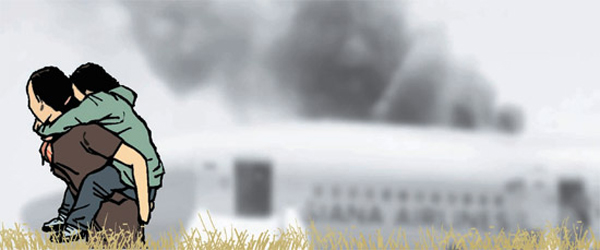A superman-like response to crisis

In their book, “On Combat: the Psychology and Physiology of Deadly Conflict in War and in Peace,” they discuss the “superman” response that happens to soldiers and police officers trained to confront deadly threats. When faced with a threat, the vision becomes clear and complicated movements become more obvious in slow motion. They only focus on the job and have no time to feel fear. The body moves automatically, and they don’t feel pain even when they’re hurt. The physiological and perceptual distortion occurs when the human body functions at full force, using all its hidden potential. The same superpower was displayed when a mother lifted a car to save her child stuck underneath.
However, ordinary people panic, rather than become a superman. The body becomes paralyzed temporarily. There’s a study that claims 85 percent of the soldiers in the U.S. Armed Forces during World War II did not fire a single round. Hollywood’s disaster films tell stories of an outsider who rises as a hero and awakens these average people. The formula goes like this: A handsome man struggles to fight against a disaster with persistence and courage. In the end, he triumphs over the ugly villains and selfish obstructors to rescue the weak and save the world.
The majority of the audience includes the vulnerable people. Grossman and Christenson claim that ordinary people can become a superman temporarily through constant and systematic training to shake off fear. Soldiers and police officers are reborn through systematic training.
Cabin manager Lee Yoon-hye helped rescue passengers from Asiana Flight 214, which crashed at San Francisco airport on Sunday in Korean time, and her courageous act may be a product of fierce training. Anyone on the crash scene could get scared in flames and smoke. But her account of the accident suggests that her courage came before instinctive fear. “When the plane smashed onto the runway, my head became clearer. I didn’t think and act, but my body moved automatically. I didn’t think about my safety until I helped all the passengers escape the scene. I suffered a coccyx fracture, but I didn’t feel the pain,” she said.
Her reaction coincides with the superman response in combat. She was so focused on her job that she couldn’t remember how many people she had saved and how long she stayed inside the plane - a sign of temporary memory loss. Her response can only be explained with constant and repeated training. Of course, her solid professionalism and devotion made evacuation possible. Yet her bravery deserves to be honored in textbooks as a model for students.
*The author is an editorial writer of the JoongAng Ilbo.
by CHAE IN-TAEK










with the Korea JoongAng Daily
To write comments, please log in to one of the accounts.
Standards Board Policy (0/250자)